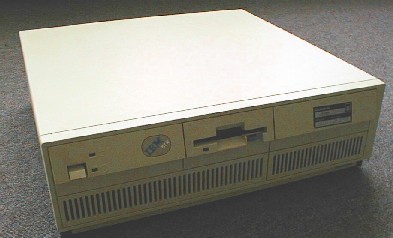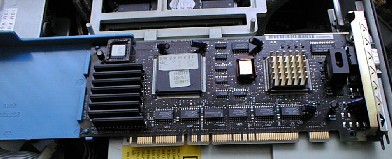
Click here or click onto the photo for a full size version of this picture.
The first generation of PS/2 systems, marked by an 85xx model number, was followed by the 95xx models. They were marked by a better video interface that allowed graphics at higher, eye-friendly screen refresh rates (a sign of this is the blue IBM badge on the front...), more peripherals and floppy drives capable of dealing with 2.88MB diskettes. For most machines, the planar was redesigned. Not so for the 90: IBM simply swapped the floppy drive (the floppy controller had to be modified to cope with the higher data rate, but this was a marginal change), and stuffed an XGA-2 graphics adapter into one of the slots. The on-board XGA(-1) automatically turns off when you plug the monitor into the XGA-2. Similarly, the on-board XGA automatically becomes the primary adapter when the monitor is plugged into the on-board video connector; a quite charming solution that can sometimes be a bit puzzling...
Since a 9590 is almost identical to a 9590, I will only show the important change(s) to the 8590:

Click here or click onto the photo for
a full size version of this picture.
This is the XGA-2 Graphics Adapter, IBM's first Microchannel video adapter that was halfway competitive and offered eye-friendly refresh rates. The video logic is the same as for the XGA-1, but it has been shrunk into fewer chips so the card is only half length compared to the full-length XGA-1. Some XGA-2's therefore have an extra-length plastic handle to get again the full length...
The clock generator is a synthesizer generator that can create arbitrary frequencies up to the DAC's capabilities (~80..90 MHz, depends upon the card's manufacturing date), allowing to adapt the video timing better to the monitor's needs. The XGA-1 only had four discrete oscillators for the 'standard' resolutions.
A final improvement of the XGA-2 is that it allows to use 16bpp modes. Since the video memory and the maximum DAC clock are however limited, you won't get more than 640x480 at 16bpp...
- Processor:
- Intel i486DX2 @ 50 MHz
- Coprocessor:
- integrated into CPU
- Cache:
- 8K internally in CPU
- Memory:
- 40 Mbytes (options range from 2M to 64M)
- Bus:
- 4 MCA slots (32 bit)
- Interfaces (onboard):
-
- Mouse, Keyboard
- 2 x Serial
- 1 x Parallel
- Floppy (1.44M), allows attachment of up to 3(!) drives
- Add-on cards:
-
- IBM SCSI Controller with Cache (2MB)
- IBM XGA-2 Graphics Accelerator
- IBM 16/4 Token Ring Adapter
- IBM 3270 Connection
- Operating System(s):
-
- Caldera OpenDOS 7.01
- Linux 2.2 (Slackware-based)
- Useful Links: